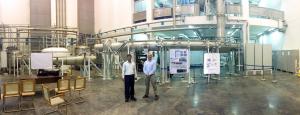Preparing to pump
27 Mar 2016
The ITER cryolines are a system of complex, multi-process, vacuum-insulated pipes that connect cryogenic components in the Cryoplant and Tokamak buildings—some 3.5 kilometres of piping in all. Their function is to provide helium at 4.5 K and 80 K to the machine's superconducting magnet system, the thermal shields and the cryo-vacuum pumps.
On a recent mission to India, the ITER Vacuum Section reviewed one of two full-size prototypes of the cryoline sections that will feed the torus cryopumps. Pictured here at the Institute of Plasma Research in Gandhinagar are Biswanath Sakar (ITER India) and Eamonn Quinn (ITER vacuum team).


